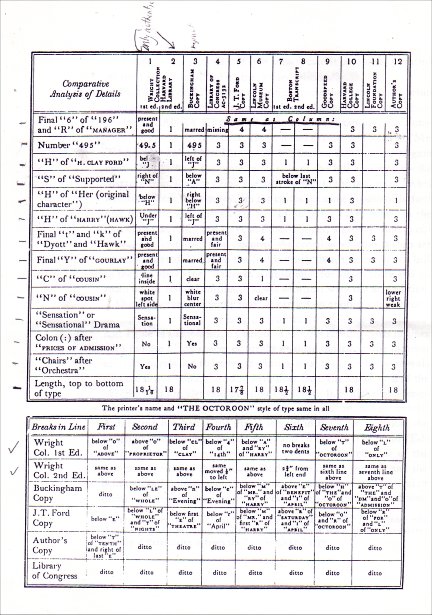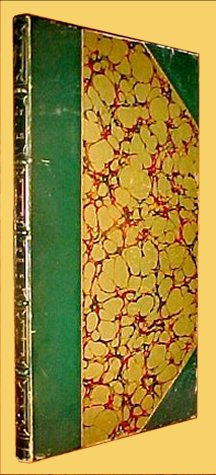

|
<<< Continued from previous page Feeling somewhat impatient, I didn't finish either of the articles. Instead I opened Brenner's article to a chart he'd assembled to document differences in issue points between genuine and counterfeit examples - and began my own investigation. The following is a photograph of the very sheet I used to check off each issue point. My marks are visible along the left side. Note also that the columns headed "1" and "2" contain the points for the two genuine playbills; the others columns represent counterfeits.

Starting with the first issue point on the (presumably) first issue playbill, I painstakingly double-checked each point, sometimes triple checked them, and slowly made my way down the page. As I put a confirming mark next to each one, I could feel my heart pound harder and harder in my chest. When I reached the bottom of the list, "Length, top to bottom of type," I was shaking, and the mark I put next to it is noticeably (and understandably) darker. I'd satisfied every last issue point. The playbill was genuine! I repeated the process with the second playbill, which bore the same issue points as the first, the only exception being that it was 1/16" longer top to bottom. Genuine again. In my excitement I picked up the phone to call Chris but then recalled that I hadn't read the articles in their entirety. It seemed practical to at least do that first in case I'd missed something important, something that might disqualify my playbills. I read the LOC article first because it was shorter - only 3 pages long. The Brenner article, however, was fully 16 pages long, and by the time I'd gotten to page 14, I was getting impatient because I'd found nothing that called my findings into question. Then, toward the bottom of page 14, I ran headlong into this: "Tending to verify the claim herein presented that the only authentic playbills and programs for the play, 'Our American Cousin,' for Friday evening, April 14, 1865, are those, or others exactly identical with those, in the Wright Collection now in the Harvard Theatre Collection, is the following important piece of source material from the library of Major William H. Lambert, of Philadelphia, whose unsurpassed collection of Lincoln material was sold at The Anderson Galleries on January 14, 1914, Part 1, after his decease, and which is now regrettably perdu in some library or broken up, and of which we can only present the catalogue entry: "299. FORD'S THEATRE PLAY-BILLS. The original play-bills issued at the Theatre the morning and evening of the day on which Lincoln was assassinated; variations and facsimiles; data concerning them; an A.L.S. by O.H. Oldroyd; together with some earlier bills of interest mounted on thick cartridge-paper, and bound in a narrow folio volume, half morocco, gilt. "The scarcest of the bills contained in this volume is the one printed in the afternoon, after it had been definitely ascertained that Lincoln would attend the performance. This is distinguished by having inserted a patriotic verse of eight lines, and by the omission of the list of prices of seats. It is extremely rare, and probably the kind used by Lincoln. The regular bill for the performance, printed in the morning, accompanies it. "In addition to these two there is another variety with the imprint of Polkinhorn, in which the word 'chairs' is omitted after 'orchestra' in the list of prices of admission, and reading 'Sensational Drama,' instead of 'Sensation Drama,' as in the others. This bill and the other issue without the verse have been declared on authority to have been found in the box after Lincoln was carried out, but it is natural to suppose that the variety with the verse especially printed in his honor would have been handed to the President and his party. "The other bills in the volume include facsimiles by other printers; the issues of the Polkinhorn bill announcing the attendance of the President; bills for previous performances in the same week; issues from Oct. 19 to 26th, when Junius Brutus Booth [EDITOR'S NOTE: Brother of John Wilkes Booth] appeared in the cast; two bills with Mrs. D. P. Bower's name; and others. "The whole forms a remarkably interesting collection, embracing every variety of the 'Lincoln bill,' including originals and forgeries." I distinctly remember gazing at this passage for some time before it finally sank in. My album contained playbills "mounted on thick cartridge-paper, and bound in a narrow folio volume, half morocco, gilt."

My album, in fact, contained every last item mentioned in this passage. I was holding the very Lambert album that had been "missing" since 1914! I'm certain I didn't even begin to cloak my excitement when I called Chris back, and in fact he was excited himself, so much so that he blurted out $50,000 as a possible auction estimate. $50,000??? I said. "Well, you never know. It could go higher." Tune in again next month for the conclusion.
Want to read more articles by
< to previous article
to next article >
Questions or comments?
| Forum
| Store
| Publications
| BookLinks
| BookSearch
| BookTopics
| Archives
| Advertise
| AboutUs
| ContactUs
| Search Site
| Site Map
| Google Site Map
Store - Specials
| BookHunt
| BookShelf
| Gold Edition & BookThink's Quarterly Market Report
| DomainsForSale
| BookThinker newsletter - free
Copyright 2003-2011 by BookThink LLC
|

|
|